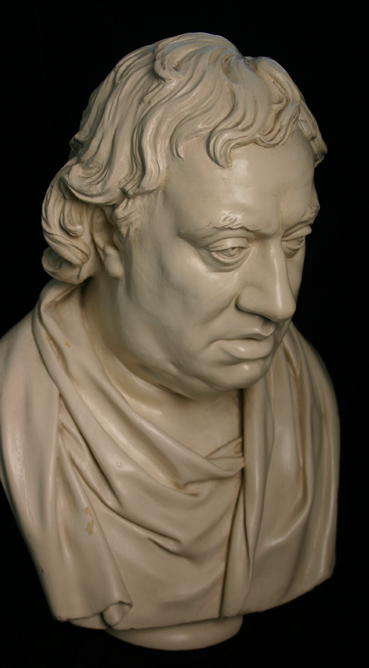Bust of Samuel Johnson by Joseph Nollekens RA, 1777
Published: 08 January 2018

Plaster Cast. Museum number 2000.63, Donated by Mrs EL Browne, 1904
In 1777 the Royal Academy annual exhibition included the only sculpture of Samuel Johnson to be taken from life. The bust by Joseph Nollekens (1737-1823) has been called the finest work that the sculptor had ever produced. However, within Johnson’s circle of friends his natural pose and wigless appearance caused much debate.
The Birthplace cast of the bust by Nollekens has an important history, as it was believed to have been given by Nollekens to John Hawkins, Johnson’s friend and executor.
Johnson and Nollekens became friends around 1772 through their mutual acquaintance Saunders Welch, whose daughter Nollekens married. Taken from the life, Johnson was a reluctant sitter. Boswell recalls one occasion when Johnson arrived very late and was berated by the sculptor, to which Johnson’s rather eccentric reply was: “Bow, wow, wow”. Nollekens intended the writer to resemble an ancient poet, with serious expression and flowing hair. He continued work on the bust between sittings, and used an Irish beggar and regular model for artists named George White as the inspiration for Johnson’s hair. Nollekens was known to be a miser and White is said to have refused the shilling that the sculptor offered him for his time, telling him that he would have earned more from begging.
The sculpture was originally created in clay, and that is likely to be the version which would have been displayed at the Royal Academy. He then cast it in plaster and also lead (now in the Victoria and Albert Museum). Unusually for Nollekens he did not carve a version in marble, although marble copies have been made by others in later years.
Johnson admitted to his step-daughter Lucy Porter that he had heard “different opinions” of the bust and that “it was condemned by Mrs Thrale, Mrs Reynolds and Mrs Garrick”. He arranged for a copy to be sent to Lichfield for her, and she admitted: “you judged rightly in thinking that the bust would not please”. He did not like it much himself, but had a great respect for his friend ‘Nolly’, calling him: “a man of reputation above any of the other sculptors”. Johnson did not generally hold the art of sculpture in high esteem, once saying that the value of statuary was in the difficulty of cutting into marble, and so “you would not value the finest head cut upon a carrot”.
The bust appears in another item in the birthplace collection, a painting attributed to Johann Zoffany RA, c.1785, showing Johnson’s friend Bennet Langton contemplating Nollekens’s work. A touching memorial to Johnson, it suggests that his representation of the writer was held in high regard. The Museum also has a tactile version of the Nollekens bust for victors to handle, created by local sculptor Allen Necchi.